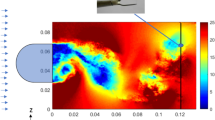Abstract
Lagrangian particle tracking enables practitioners to study various concepts in turbulence by measuring particle positions in flows of interest. These data are subject to measurement errors; filtering techniques are applied to mitigate these errors and improve the accuracy of analyses utilizing the data. We develop a new type of position filter through use of maximum likelihood estimation by considering both measurement errors and stochastic process physics. The maximum likelihood estimation scheme we develop is general, enabling it to be applied to many different turbulent flows. We propose a process model similar to existing, complimentary work in the development of B-splines. We compare our filtering scheme to existing schemes and find that our filter out performs the scheme proposed by (Mordant et al. Physica D 193(1):245–251, 2004) considerably, and produces similar performance to spline filters, proposed by (Gesemann arXiv preprint arXiv:1510.09034, 2015). We note that the maximum likelihood treatment provides a general framework which is capable of producing different filters based on the physics of interest, whereas the spline filters are built on less specific filtering theory and are therefore more difficult to adapt across diverse use cases in fluids. We quantify the performance of each of the filtering methods using error metrics which consider both noise reduction as well as signal degradation, and together these are used to define a concept of filter efficiency. The maximum likelihood filter developed in this work is applied to simulated isotropic turbulence data from the Johns Hopkins Database.






Similar content being viewed by others
Availability of data and materials
Data and codes are available from the authors upon request.
References
Ayyalasomayajula S, Warhaft Z, Collins LR (2008) Modeling inertial particle acceleration statistics in isotropic turbulence. Phys Fluids 20(9):095104. https://doi.org/10.1063/1.2976174
Bullerjahn JT, Hummer G (2021) Maximum likelihood estimates of diffusion coefficients from single-particle tracking experiments. J Chem Phys 154(23):234105. https://doi.org/10.1063/5.0038174
Celis C, Figueira da Silva LF (2015) Lagrangian mixing models for turbulent combustion: review and prospects. Flow Turbul Combust 94:643–689. https://doi.org/10.1007/s10494-015-9597-1
Crawford AM (2004) Particle tracking measurements in fully developed turbulence: water and dilute polymer solutions. PhD thesis, Cornell University
Gesemann S (2015) From particle tracks to velocity and acceleration fields using b-splines and penalties. arXiv preprint arXiv:1510.09034
Gesemann S (2021) Trackfit: uncertainty quantification, optimal filtering and interpolation of tracks for time-resolved lagrangian particle tracking. In: 14th International Symposium on Particle Image Velocimetry
Herzog S, Schiepel D, Guido I et al (2021) A probabilistic particle tracking framework for guided and Brownian motion systems with high particle densities. SN Comput. Sci. 2:1–20
Kähler CJ, Scharnowski S, Cierpka C (2012) On the resolution limit of digital particle image velocimetry. Exp Fluids 52:1629–1639. https://doi.org/10.1007/s00348-012-1280-x
Lawson JM, Bodenschatz E, Lalescu CC et al (2018) Bias in particle tracking acceleration measurement. Exp Fluids 59:1–14. https://doi.org/10.1007/s00348-018-2622-0
Li Y, Perlman E, Wan M et al (2008) A public turbulence database cluster and applications to study Lagrangian evolution of velocity increments in turbulence. J Turbul 9:N31. https://doi.org/10.1080/14685240802376389
Mordant N, Metz P, Michel O et al (2001) Measurement of Lagrangian velocity in fully developed turbulence. Phys Rev Lett 87(21):214501. https://doi.org/10.1103/PhysRevLett.87.214501
Mordant N, Crawford A, Bodenschatz E (2004) Experimental Lagrangian acceleration probability density function measurement. Physica D 193(1):245–251. https://doi.org/10.1016/j.physd.2004.01.041
Ouellette NT, Xu H, Bodenschatz E (2006) A quantitative study of three-dimensional Lagrangian particle tracking algorithms. Exp Fluids 40:301–313. https://doi.org/10.1007/s00348-005-0068-7
Perlman E, Burns R, Li Y, et al (2007) Data exploration of turbulence simulations using a database cluster. In: Proceedings of the 2007 ACM/IEEE Conference on Supercomputing. Association for Computing Machinery, New York, NY, USA, SC ’07, https://doi.org/10.1145/1362622.1362654
Saffman PG, Turner JS (1956) On the collision of drops in turbulent clouds. J Fluid Mech 1(1):16–30. https://doi.org/10.1017/S0022112056000020
Savitzky A, Golay MJ (1964) Smoothing and differentiation of data by simplified least squares procedures. Anal Chem 36(8):1627–1639
Sawford BL, Yeung PK, Borgas MS et al (2003) Conditional and unconditional acceleration statistics in turbulence. Phys Fluids 15(11):3478–3489. https://doi.org/10.1063/1.1613647
Sciacchitano A, Leclaire B, Schroeder A (2021) Main results of the first lagrangian particle tracking challenge. In: Proceedings of 14th international symposium on particle image velocimetry, ILLINOIS Tech/Paul V. Galvin Library, pp 1–14
Voth GA, La Porta A, Crawford AM et al (2002) Measurement of particle accelerations in fully developed turbulence. J Fluid Mech 469:121–160. https://doi.org/10.1017/S0022112002001842
Weil J, Sykes R, Venkatram A (1992) Evaluating air-quality models: review and outlook. J Appl Meteorol Clim 31(10):1121–1145. https://doi.org/10.1175/1520-0450(1992)031<1121:EAQMRA>2.0.CO;2
Funding
No funding was received to assist with the preparation of this manuscript.
Author information
Authors and Affiliations
Contributions
GMK and RVK contributed to the study conception and design; KML and RVK collected data; GMK analyzed the data with support from KML; GMK and KML wrote the manuscript; all authors reviewed and revised the manuscript.
Corresponding authors
Ethics declarations
Conflicts of interest
The authors declare no competing interests.
Ethical approval
Not applicable.
Additional information
Publisher's Note
Springer Nature remains neutral with regard to jurisdictional claims in published maps and institutional affiliations.
Appendix 1 Proof of Proposition 1
Appendix 1 Proof of Proposition 1
Proof
is equivalent to
with \(\mu = \frac{m \sigma }{\sigma _F}\). Computing the gradient of the objective with respect to x, and setting it equal to zero, yields the optimization condition
This is simplified through standard manipulations to the expression
The matrix \(\mu ^2 A^T \Delta ^T \Delta A\) is positive semi-definite, and therefore the matrix sum \(I + \mu ^2 A^T \Delta ^T \Delta A\) is positive definite and thus permits an inverse in general. Therefore the minimizing x of the objective is generally written in terms of this inverse as
\(\square\)
Rights and permissions
Springer Nature or its licensor (e.g. a society or other partner) holds exclusive rights to this article under a publishing agreement with the author(s) or other rightsholder(s); author self-archiving of the accepted manuscript version of this article is solely governed by the terms of such publishing agreement and applicable law.
About this article
Cite this article
Kearney, G.M., Laurent, K.M. & Kearney, R.V. Maximum likelihood filtering for particle tracking in turbulent flows. Exp Fluids 65, 24 (2024). https://doi.org/10.1007/s00348-024-03765-5
Received:
Revised:
Accepted:
Published:
DOI: https://doi.org/10.1007/s00348-024-03765-5




